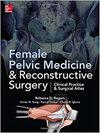Effect of COVID-19 on Female Pelvic Medicine and Reconstructive Surgery Fellowship Education and Training
IF 1.4
4区 医学
Q3 OBSTETRICS & GYNECOLOGY
Female Pelvic Medicine and Reconstructive Surgery
Pub Date : 2022-04-02
DOI:10.1097/SPV.0000000000001175
引用次数: 3
Abstract
Importance The COVID-19 pandemic has caused a noticeable disruption in national medical and surgical care, including medical training. Objectives We designed a survey to examine the educational effect of the pandemic on female pelvic medicine and reconstructive surgery (FPMRS) training and secondarily to identify areas for innovation and opportunity in FPMRS fellowship training. Study Design We used an online survey, approved by the American Urogynecologic Society Scientific Committee and distributed it to FPMRS fellows with responses obtained and stored in REDCap. Demographic data, educational and surgical experiences, the implications of the changes, and data regarding working from home were collected. Results The survey was completed by 88 fellows, with 92% of respondents being obstetrics and gynecology- based. All 10 geographic regions had at least one response. Six regions had a 50% or greater redeployment rate. Only 16% of respondents were not redeployed or on-call to be redeployed. Eighty-five percent of the ob/gyn fellow redeployments were within their home department. There was no relationship between training region and redeployment. Only 31.7% of the respondents continued to perform any FPMRS surgery. Approximately 35% of the fellows desired the opportunity for surgical simulation training because surgical cases were reduced. No relationship was seen between either redeployment status and needs (P = 0.087–0.893) or difficulties (P = 0.092–0.864) nor training location and needs (P = 0.376–0.935) or difficulties (P = 0.110–0.921). Conclusions There was a high rate of redeployment among fellows; however, this was not associated with their reported needs and difficulties. The FPMRS-related surgical experience was affected during this time, and the fellows desired increased surgical simulation training.新型冠状病毒肺炎对女性骨盆内科及重建外科医师教育培训的影响
重要性新冠肺炎大流行对包括医疗培训在内的国家医疗和外科护理造成了明显干扰。目的我们设计了一项调查,以检查疫情对女性骨盆医学和重建外科(FPMRS)培训的教育影响,其次确定FPMRS奖学金培训的创新和机会领域。研究设计我们使用了一项由美国泌尿妇科学会科学委员会批准的在线调查,并将其分发给FPMRS研究员,获得并存储在REDCap中。收集了人口统计数据、教育和手术经验、变化的影响以及在家工作的数据。结果本次调查共有88名研究人员参与,其中92%的调查对象为妇产科。所有10个地理区域都至少有一个答复。六个地区的重新部署率达到或超过50%。只有16%的受访者没有被重新部署或随时待命。85%的妇产科同事被重新部署在他们的家庭部门。训练区域和重新部署之间没有关系。只有31.7%的受访者继续进行任何FPMRS手术。大约35%的研究员希望有机会进行手术模拟培训,因为手术病例减少了。调动状态与需求(P=0.087–0.893)或困难(P=0.092–0.864)、培训地点与需求(0.376–0.935)或困难之间均无相关性(P=0.110–0.921);然而,这与他们报告的需求和困难无关。在这段时间里,FPMRS相关的手术经验受到了影响,研究人员希望增加手术模拟训练。
本文章由计算机程序翻译,如有差异,请以英文原文为准。
求助全文
约1分钟内获得全文
求助全文
来源期刊

Female Pelvic Medicine and Reconstructive Surgery
OBSTETRICS & GYNECOLOGY-
CiteScore
2.10
自引率
12.50%
发文量
228
期刊介绍:
Female Pelvic Medicine & Reconstructive Surgery, official journal of the American Urogynecologic Society, is a peer-reviewed, multidisciplinary journal dedicated to specialists, physicians and allied health professionals concerned with prevention, diagnosis and treatment of female pelvic floor disorders. The journal publishes original clinical research, basic science research, education, scientific advances, case reports, scientific reviews, editorials and letters to the editor.
 求助内容:
求助内容: 应助结果提醒方式:
应助结果提醒方式:


